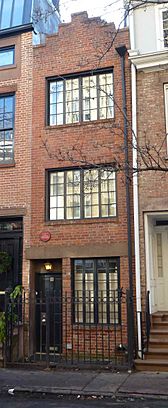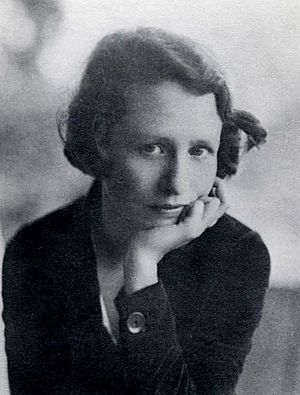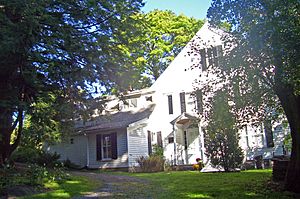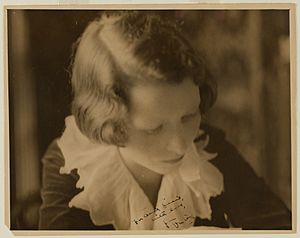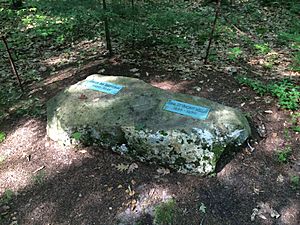Edna St. Vincent Millay facts for kids
Quick facts for kids
Edna St. Vincent Millay
|
|
|---|---|

Millay, photographed by Carl Van Vechten, 1933
|
|
| Born | February 22, 1892 Rockland, Maine, US |
| Died | October 19, 1950 (aged 58) Austerlitz, New York, US |
| Pen name | Nancy Boyd |
| Occupation |
|
| Alma mater | Vassar College |
| Notable awards | Pulitzer Prize for Poetry (1923) Robert Frost Medal (1943) |
| Spouse |
Eugen Jan Boissevain
(m. 1923; died 1949) |
| Signature | |
 |
|
Edna St. Vincent Millay (born February 22, 1892 – died October 19, 1950) was an American poet and playwright. She was famous for her lyrical poems, which are like songs that express strong feelings. Millay was also a well-known public figure and a supporter of women's rights in New York City. This was especially true during the 1920s, a time known as the Roaring Twenties. She often used the pen name Nancy Boyd for some of her writings.
Millay won the 1923 Pulitzer Prize for Poetry for her poem "Ballad of the Harp-Weaver". She was the first woman to win this important award for poetry. Later, in 1943, she received the Frost Medal for her amazing contributions to American poetry throughout her life.
Many people admired Millay's work during her lifetime. A famous writer named Edmund Wilson even called her one of the greatest poets writing in English at the time. However, in the 1930s, some critics started to dislike her style. They preferred newer, more modern poetry. But later, in the 1960s and 1970s, people became interested in her work again, especially those who studied women's literature.
Contents
Early Life and Growing Up
Edna St. Vincent Millay was born in Rockland, Maine, on February 22, 1892. Her mother, Cora, was a nurse, and her father, Henry, was a schoolteacher. Millay's middle name, "St. Vincent," came from a hospital in New York City. Her uncle's life was saved there just before she was born.
Her mother encouraged Edna and her two younger sisters, Norma and Kathleen, to read classic books. Even though Edna was very smart, she found formal school difficult because she was quite rebellious. But she started winning poetry prizes when she was very young.
In 1904, her parents divorced. Cora and her three daughters moved often and lived simply. Cora always carried a trunk full of classic books by writers like Shakespeare and Milton. She would read these stories to her children. The family eventually settled in a small house in Camden, Maine. This is where Millay wrote some of her first famous poems. Their home was a lovely place, surrounded by mountains and the sea.
The three sisters were very independent and always spoke their minds. This sometimes caused problems with adults. For example, Millay's grade school principal refused to call her "Vincent," which she preferred. Instead, he would call her other names starting with "V." At Camden High School, Millay began to develop her writing skills. She wrote for the school's literary magazine. By age 14, she won a poetry award, and by 15, her poems were published in popular magazines.
Becoming Famous and College Years
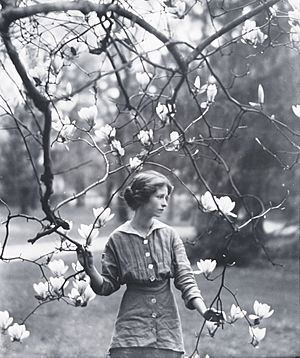
Millay's journey to fame began in 1912. She was 20 years old when she entered her poem "Renascence" in a poetry contest. The contest organizer, Ferdinand P. Earle, chose Millay as the winner. However, the other judges disagreed. They felt the winning poem should have a social message, which "Renascence" did not.
This disagreement caused a big stir in newspapers. It helped launch the careers of both Millay and another poet, Orrick Glenday Johns. Johns even felt Millay's poem was better and avoided the awards ceremony. A wealthy supporter of the arts, Caroline B. Dow, heard Millay read her poetry. She was so impressed that she offered to pay for Millay to go to Vassar College.
Millay started at Vassar College in 1913, a bit older than most students. She found Vassar's strict rules challenging. Before college, she had a very free home life. At Vassar, students were expected to be very proper. Even though she sometimes broke rules, the college often overlooked it because of her talent. She was a well-known writer on campus and wrote for the college's magazine. She graduated in 1917.
Life in Greenwich Village
After graduating from Vassar in 1917, Millay moved to New York City. She settled in Greenwich Village, an area known for its artists and writers. She lived in several interesting places, including a very narrow house at 75½ Bedford Street.
In New York City, Millay made many friends who were also writers. These included Floyd Dell and Edmund Wilson. She also worked with theater groups like the Provincetown Players. In 1919, she wrote an anti-war play called Aria da Capo. Her sister Norma starred in it. In 1923, Millay helped start the Cherry Lane Theatre to put on new and experimental plays.
During her time in Greenwich Village, Millay used her poetry to support women's rights. She often wrote about topics that others considered too sensitive. Her 1920 poetry collection, A Few Figs From Thistles, caused some discussion because it explored ideas about feminism. She also traveled across the country, giving popular public readings of her poems.
To earn money, Millay wrote short stories for a magazine. She wanted to protect her reputation as a serious poet. So, she published these more popular stories using her pen name, Nancy Boyd.
Pulitzer Prize and Marriage
In 1921, Millay traveled to Paris, France. There, she met artists like Man Ray. In 1923, she won the Pulitzer Prize for Poetry for "The Ballad of the Harp-Weaver." She was the first woman to win this specific poetry prize. A famous critic even called her "the greatest woman poet since Sappho."
In 1923, Millay married Eugen Jan Boissevain. He was a kind man who supported her career as a writer. He also took care of many household tasks. Both Millay and Boissevain had other close friendships during their 26-year marriage. One of Millay's important friendships was with a younger poet named George Dillon. Their connection inspired her collection of poems called Fatal Interview, published in 1931.
In 1925, Millay and Boissevain bought a large property called Steepletop in Austerlitz, New York. It was once a blueberry farm. They built a barn, a writing cabin, and a tennis court. Millay enjoyed growing vegetables in her garden. They also bought an island in Maine as a summer getaway.
Millay was asked by the Metropolitan Opera to write the story for an opera. The opera, called The King's Henchman, was based on an old English story. It opened in 1927 and was highly praised. The New York Times called it a very well-made American opera.
In 1927, Millay and other writers were arrested for protesting. They were trying to stop the executions of two Italian American men, Nicola Sacco and Bartolomeo Vanzetti. Millay even met with the governor to ask for a new trial. Her failure to stop the executions deeply affected her. It made her more interested in political issues, which showed up in her later poems.
Accident and War Efforts
In May 1936, Millay was staying at a hotel when a fire broke out. Everything was destroyed, including the only copy of her long poem, Conversation at Midnight. She later rewrote the entire poem from memory.
In the summer of 1936, Millay was in a car accident. She was thrown from the car and badly injured her spine. This accident caused her constant pain for the rest of her life. She needed many surgeries and hospital stays.
Despite her pain, Millay was very worried about the rise of fascism in the world. During World War I, she had been against war. But by 1940, she strongly believed the U.S. should join World War II against the Axis powers. She became a strong supporter of the war effort. She even worked with the Writers' War Board to create poems and other writings to support the war. Some critics disliked her for this, but she felt it was important to fight for democracy.
In 1942, Millay wrote about the destruction of the Czech village of Lidice. Nazi forces had destroyed the village and killed its male residents. Millay wrote: "The whole world holds in its arms today / The murdered village of Lidice, / Like the murdered body of a little child." This poem was later made into a book and even a movie.
Millay was also critical of capitalism and was interested in socialist ideas. She believed in a "free and equal society."
Even though her books sold well in the 1930s, her health problems and her sister's needs meant she was often in debt. It also seems she developed a love for horse-racing and spent a lot of money on her own racing stable.
Later Years and Passing
Boissevain, Millay's husband, passed away in 1949 from lung cancer. Millay lived alone for the last year of her life. Her last collection of poems, "Mine the Harvest," was published after her death.
Edna St. Vincent Millay died at her home on October 19, 1950, when she was 58 years old. She was found at the bottom of her stairs with a broken neck. Her doctor believed she had a heart attack. She is buried next to her husband at Steepletop.
Her Legacy and Impact
After her death, The New York Times called Millay "an idol of the younger generation" and "one of the greatest American poets of her time." Even the famous writer Thomas Hardy said that America had two great things: skyscrapers and Millay's poetry. Another poet, Richard Wilbur, said she wrote some of the best sonnets of her century.
While some critics later thought her work was not as strong, her biography, Savage Beauty: The Life of Edna St Vincent Millay, helped people understand her better. Her sister, Norma, gave the biographer access to Millay's personal papers. This book helped people see Millay as a "herald of the New Woman," someone who announced a new era for women.
Millay was also recognized as one of the "31 Icons" for LGBT History Month in 2015.
Places Connected to Millay
Millay's sister Norma and her husband moved to Steepletop after Millay passed away. In 1973, they created the Millay Colony for the Arts on part of the property. This is a place where artists can come to work. After Norma's death, the poet Mary Oliver helped organize Millay's papers. Mary Oliver later became a Pulitzer Prize-winning poet herself, inspired by Millay. In 2006, the state of New York bought some of Steepletop's land to add to a nearby forest. The money from this sale helped restore Millay's farmhouse and turn it into a museum. The museum opened in 2010.
Work also began in 2015 to restore Millay's birthplace in Rockland, Maine. This house was added to the National Register of Historic Places. Once fully restored, half of the house will honor Millay's legacy with workshops and classes. The other half will be rented out to help pay for the house's upkeep and programs. A writer will also live there, supported by a foundation.
Millay is also remembered in Camden, Maine, where she lived starting in 1900. A statue of her stands in Harbor Park. This park has a view of Penobscot Bay, which is mentioned in her famous poem "Renascence." The Camden Public Library also has lines from "Renascence" written around a large skylight: "All I could see from where I stood / Was three long mountains and a wood; / I turned and looked another way, / And saw three islands in a bay." The library also keeps many of Millay's old photos, letters, and other items.
Famous Works
Edna St. Vincent Millay wrote several plays early in her career.
Her poem "Euclid alone has looked on Beauty bare" (1922) is a tribute to the ideas of geometry. Her poems "Renascence" and "The Ballad of the Harp-Weaver" are often considered her very best.
Images for kids
See also
 In Spanish: Edna St. Vincent Millay para niños
In Spanish: Edna St. Vincent Millay para niños
- 75½ Bedford Street — A very narrow house where Millay lived in New York City.
- Greenwich Village — The neighborhood in New York City where Millay lived and worked.
- Inez Milholland — The first wife of Millay's husband, Eugen Jan Boissevain.
- Nancy Milford — The person who wrote a biography about Millay.
- Norma Millay — Edna St. Vincent Millay's sister.
- Vassar College — The college Millay attended.


